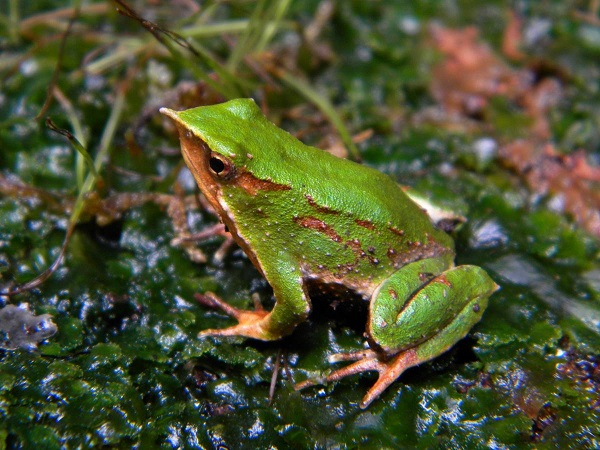
In the vast world of amphibians, a peculiar creature stands out for its unique and fascinating survival strategy – the Darwin Frog (Rhinoderma darwinii). Named after the renowned naturalist Charles Darwin, this extraordinary amphibian has captivated researchers and nature enthusiasts alike. Native to the temperate rainforests of Chile and Argentina, the Darwin Frog has evolved an exceptional method of parental care that sets it apart from other amphibians. In this article, we will delve into the intriguing life of the Darwin Frog and explore how it has adapted to thrive in its demanding environment.
Physical Characteristics
The Darwin Frog is a small amphibian, with adult males measuring around 1 inch and females being slightly larger, reaching up to 1.6 inches. As with many amphibians, they have smooth, moist skin that facilitates respiration through the skin. Their coloration typically ranges from light brown to dark green, allowing them to blend seamlessly into their lush surroundings.
Unique Adaptation: Mouthbrooding
What truly sets the Darwin Frog apart from other species is its incredible method of parental care. Male Darwin Frogs exhibit an extraordinary adaptation known as mouthbrooding, which involves the male carrying the developing tadpoles in his vocal sac.
The breeding process begins with courtship displays, during which the male lures a female to his chosen nesting site, typically near a stream or pond. The female lays her eggs, which the male fertilizes externally. Once fertilization is complete, the male gathers the eggs into his mouth, where they remain protected and nourished until hatching.
Parental Role Reversal
The mouthbrooding strategy in Darwin Frogs represents a rare case of parental role reversal. It is the male who assumes responsibility for the crucial early stages of offspring development, safeguarding the eggs from potential threats and providing an optimal environment for their growth. This method of parental care allows the female to disperse and produce additional clutches of eggs, increasing the chances of successful reproduction.
Hatching and Tadpole Care
Throughout the incubation period, which lasts approximately two to three weeks, the male carefully guards the developing tadpoles within his vocal sac. He avoids eating during this period, subsisting on secretions from his mouth that nourish the developing offspring. When the tadpoles are fully developed and ready to metamorphose, the male releases them into the water, where they continue their transformation into froglets.
Challenges and Conservation Status
Despite its remarkable adaptations, the Darwin Frog faces various threats that endanger its survival. Destruction of its natural habitat due to deforestation and pollution are significant contributors to the decline of Darwin Frog populations. Additionally, the introduction of invasive species and the spread of infectious diseases pose further risks.
As a result of these challenges, the Darwin Frog has been classified as “Endangered” by the International Union for Conservation of Nature (IUCN). Conservation efforts are critical to protect and restore the fragile ecosystems where these unique amphibians reside.
Conclusion
The Darwin Frog’s mouthbrooding adaptation and parental role reversal offer a glimpse into the incredible diversity and complexity of life in the animal kingdom. Through this remarkable survival strategy, the Darwin Frog has managed to thrive in its challenging habitat, showcasing the brilliance of natural selection and evolution.
9 Fun Facts About the Darwin Frog
Mouthbrooding Marvel
As mentioned earlier, the Darwin Frog is famous for its unique method of parental care known as mouthbrooding. The male carries the developing tadpoles inside his vocal sac until they are fully developed, offering them protection and nourishment.
Parental Role Reversal
In most animal species, it is the female that takes care of the offspring, but the Darwin Frog defies convention. The male frog is solely responsible for the care and development of the eggs and tadpoles, while the female is free to disperse and produce more clutches of eggs.
Tiny Size
The Darwin Frog is one of the world’s smallest frog species. Adult males typically measure around 1 inch in length, while females are slightly larger, reaching up to 1.6 inches.
Camouflage Masters
Their coloration varies from light brown to dark green, allowing them to blend seamlessly into the leaf litter and vegetation of their rainforest habitat. This exceptional camouflage helps them evade predators and remain inconspicuous.
Secretive Dwellers
Darwin Frogs are secretive and nocturnal creatures, preferring to remain hidden during the day to avoid predators. Their elusive behavior makes them challenging to spot in the wild.
Found in the Southern Cone
The Darwin Frog is native to the temperate rainforests of Chile and Argentina, predominantly found in the southern regions of these countries. They are well-adapted to the cool and moist environment of these regions.
Discovered by Charles Darwin
The Darwin Frog was first collected and described by naturalist Charles Darwin during his historic voyage on the HMS Beagle. He encountered the species in Chile in the early 1830s and later sent specimens to England for study.
Vocal Sac Amplification
Male Darwin Frogs use their vocal sac not just for mouthbrooding, but also for amplifying their calls during the mating season. This allows them to attract females and establish territories.
Silent Fathers
Once the tadpoles are released into the water, the male Darwin Frogs no longer engage in any further parental care. They do not provide any protection or nourishment to the froglets after they leave the vocal sac.
Related Articles & Free Email Newsletter Sign Up
Giant Salamanders are the Largest Amphibians in the World
How Animals Have Served the Military


Comment here